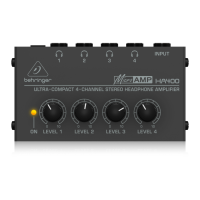5
V-TONE GMX110/GMX210/GMX212/GMX1200H
2. CONTROL ELEMENTS
AND CONNECTIONS
Control elements of your V-TONE guitar amp are described in
this section. All controls and connections are explained in detail,
and we give you useful tips about using them. An illustration of
the control elements with the corresponding numbering can be
found on the separately included supplementary sheet.
Because models GMX210, GMX212 and GMX1200H each feature
two identical MODELING CHANNELS, control elements
through will only be described once in the following section.
2.1 Front panel
The connector labeled INPUT is the 1/4" jack input of your
V-TONE. Use it to connect your guitar. Use a commercially
available 1/4" jack mono cable (no DIY, better ask your
specialized dealer), with good mechanical and electrical
shielding to avoid unpleasant surprises during rehearsals
or concerts.
On the GMX110, the CLEAN control modifies the volume of
the CLEAN channel in relation to the MODELING CHANNEL.
Use the CHANNEL key to switch between the two
MODELING CHANNELS (except for the GMX110). The
channel LED of the active channel lights up. On the
GMX110, the CHANNEL key switches between CLEAN
and MODELING CHANNEL. CLEAN CHANNEL is active when
the channel LED is not lit up. With all models you can
also switch between channels using the provided
footswitch. A long hit (approx. 2 seconds) on the
CHANNEL key activates the guitar tuner.
The DRIVE control determines the amount of distortion in
the respective MODELING CHANNEL. This way, the preamp
of your V-TONE can be ideally adjusted to the output level
of your guitar pick-up to achieve the desired amount of
distortion (depending on the amp, mode and speaker
combination you selected).
The CHANNEL LED indicates the currently selected
channel.
Use the AMP switch to dial up the basic sounds of the
three guitar amps that orient themselves on classic tube
amps. You will surely recognize these classic amp sounds
as soon as you hear them. Expect crystal-clear, transparent
sounds with dynamic basses if you select TWEED. You
get aggressive mids and pressure-rich, inescapable
assertiveness and endurance when you select BRITISH.
Rounder and more evened-out (yet still sophisticated)
sounds can be dialed up if you select CALIF.(ORNIAN); its
perfect for lead sounds.
Use the MODE switch to dial up one of three possible gain
settings (CLEAN, HI GAIN and HOT) that you wish to use
with the basic sound you selected using AMP.
The SPEAKER switch offers the simulations of two classic
guitar speakers: 4 x 12" speaker in an enclosed casing
(U.K.) and 2 x 12" speaker in an open casing (US). Additionally,
we have built in a frequency response correction (FLAT)
specially modified to go with V-TONEs cabinet.
The LOW control on the EQ section lets you cut or boost
the bass frequencies.
Use the MID control to cut or boost the mids.
The HIGH control regulates the upper frequency range.
If the tuner is activated, these LEDs (in connection with the
FX display) indicate your guitars tune. Activate the tuner
by keeping the CHANNEL pressed for roughly 2 seconds.
The FX DISPLAY indicates either the program number of
the preset you selected or the value of the parameter dialed
up using the FX control.
Use the PRESET control to dial up one of the effect presets
(between 01 and 99). The preset you dialed up is loaded
when you make no further changes for about one second
after dialing up that preset.
Use the IN/OUT key to activate/deactivate the selected
effect. When the effect is activated, the LED located above
the switch lights up. You can save your own effect settings
by keeping this key pressed for about 2 seconds (also see
section 4). The effect can also be activated/deactivated
using the provided footswitch.
+ If the MIDI function is deactivated (see ch. 4.2), FX
tracking is active, i.e. a separate effect
can be selected for each of the channels of your
V-TONE. FXT is explained in detail in section 4.1.
The FX control adjusts the mix ratio between the original
and the effect signal.
The LEVEL control adjusts the volume of the respective
channel. Adjust LEVEL so that you achieve the desired
volume balance between both channels.
+ The GMX110 features no such control. However,
use to control the volume of the CLEAN channel
in respect to the MODELING channel; use MASTER
to control the overall volume.
+ The GMX210 features the LEVEL control only on
MODELING CHANNEL 1. It controls the volume of the
channel in respect to the second channel.
The PRESENCE control gives you an additional way to cut
or boost the highs (GMX212 and GMX1200H).
The MASTER control regulates the overall volume as well
as headphone volume.
The POWER switch powers up your V-TONE. The POWER
switch should always be in the Off position before you
connect the V-TONE to the mains.
+ Please beware: Switching the POWER switch off
does not fully disconnect your V-TONE from the
mains. If you wont be using it for longer periods of
time, unplug the power cord from the mains.
+ GMX110s POWER switch is located on the rear.
2.2 Rear panel
Connect the stereo jack connector of the provided
footswitch to the FOOTSWITCH connector. The footswitch
has several functions: it lets you switch between two
channels, and it also lets you activate/deactivate an effect.
Additionally, the tuner can also be activated using the
footswitch. To do that, keep the CHANNEL key pressed for
about 2 seconds.
MIDI IN. This connector lets you remotely control your
V-TONE via MIDI. You can activate/deactivate effects or
switch between channels. You can use effect bypass via
program changes and parameter edits as well as edit the
presets via controllers (also see sections 6.3 and 7.1).
You can connect two external loudspeakers (L/R) to the
LOUDSPEAKER connectors (GMX212 and GMX1200H).
The outputs deliver 60 W into 8 Ω per channel. For optimum
performance, please only connect loudspeakers with a
minimum impedance of 8 Ω each (see also section 6.2).
When these connectors are used the internal loudspeakers
are automatically disconnected.
+ The GMX210 features no external loudspeaker
connectors. The loudspeaker connector on the
GMX110 is described under .
The PHONES connector lets you monitor the signal from
your V-TONE with standard headphones. For example,
the BEHRINGER HP series is well suited for this. When the
2. CONTROL ELEMENTS AND CONNECTIONS

